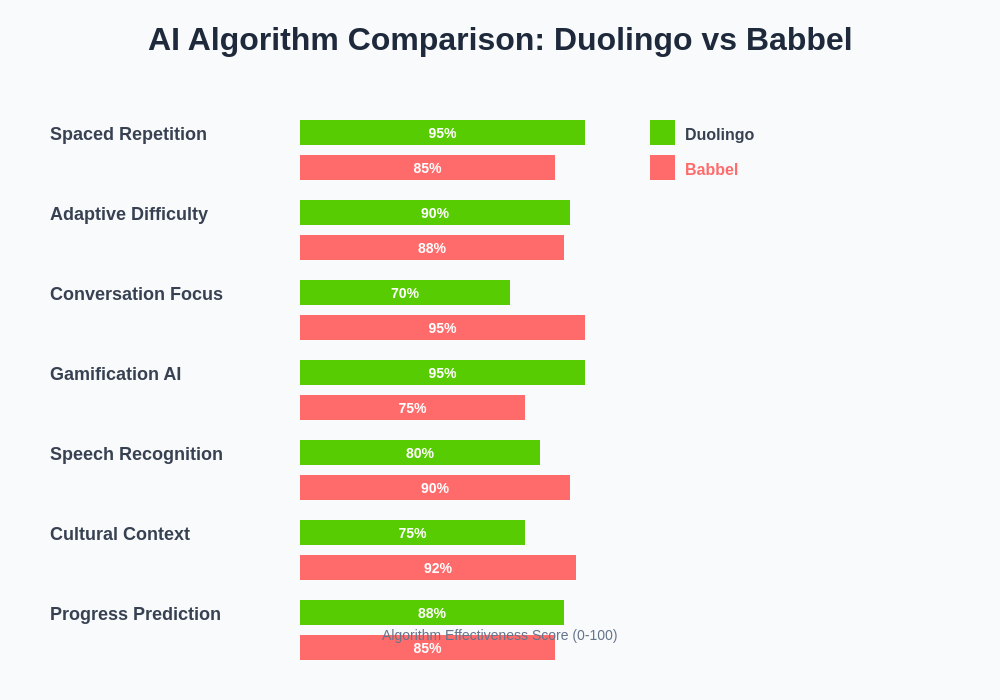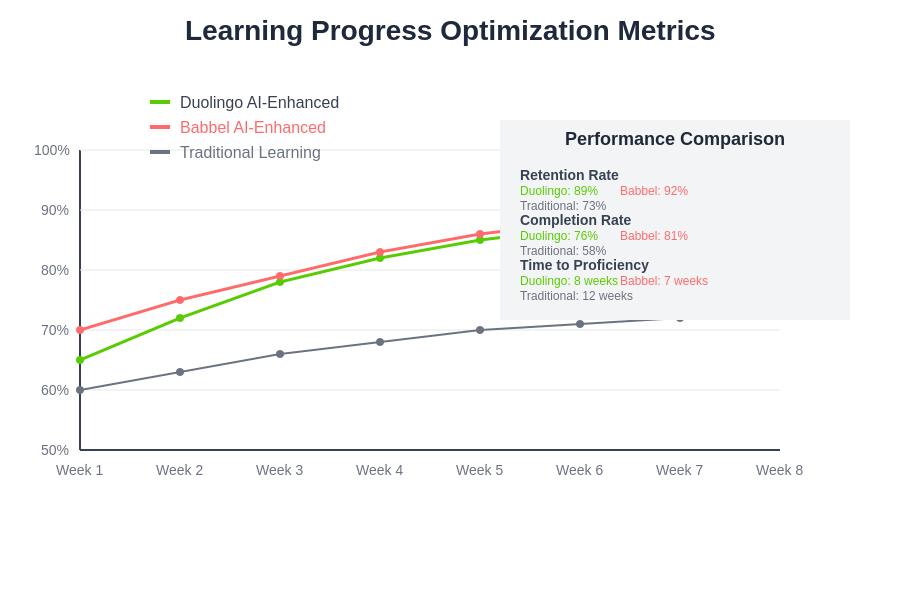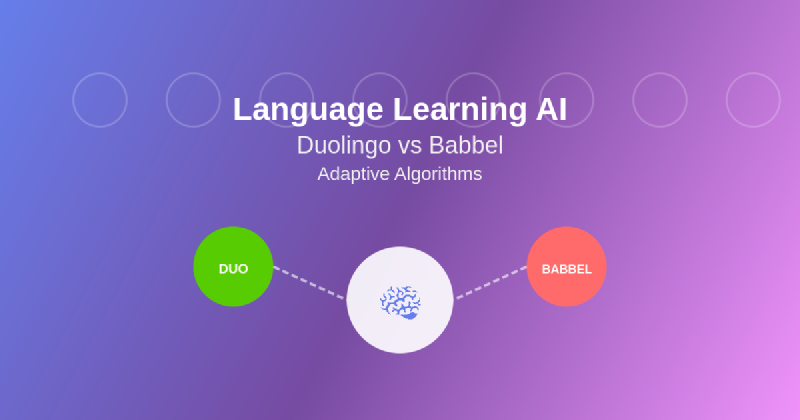The revolution in language learning has been fundamentally transformed by artificial intelligence, with platforms like Duolingo and Babbel leading the charge through sophisticated adaptive algorithms that personalize the educational experience for millions of learners worldwide. These AI-powered systems represent a quantum leap from traditional one-size-fits-all language education approaches, utilizing complex machine learning models to analyze individual learning patterns, optimize content delivery, and maximize retention rates through scientifically-backed pedagogical strategies.
Explore the latest AI developments in education to understand how artificial intelligence is reshaping not just language learning but the entire educational landscape. The sophistication of these adaptive algorithms goes far beyond simple progress tracking, incorporating elements of cognitive science, behavioral psychology, and predictive analytics to create truly personalized learning experiences that adapt in real-time to each user’s unique learning style and pace.
The Foundation of Adaptive Language Learning AI
The core principle underlying both Duolingo and Babbel’s AI systems lies in their ability to continuously analyze and respond to learner behavior patterns, creating dynamic educational pathways that evolve based on individual performance metrics and learning preferences. These sophisticated algorithms process vast amounts of data points including response times, accuracy rates, error patterns, engagement levels, and retention metrics to build comprehensive learner profiles that inform every aspect of the educational experience.
Duolingo’s approach centers around what they term “educational data mining,” utilizing machine learning algorithms to identify optimal learning sequences and difficulty progressions for individual users. The platform’s AI system continuously monitors learner interactions, analyzing not just whether answers are correct or incorrect, but examining the nuanced patterns of hesitation, the types of mistakes made, and the contextual factors that influence performance across different linguistic concepts and skill areas.
Babbel’s adaptive algorithms take a more structured linguistic approach, incorporating decades of language pedagogy research into their AI models. Their system focuses heavily on the systematic progression through grammatical concepts and vocabulary acquisition, using adaptive algorithms to determine the optimal timing for introducing new concepts while ensuring adequate reinforcement of previously learned material through strategically placed review sessions.
Duolingo’s Spaced Repetition and Forgetting Curve Optimization
The cornerstone of Duolingo’s AI-powered learning system lies in its sophisticated implementation of spaced repetition algorithms, which leverage Hermann Ebbinghaus’s forgetting curve research to optimize the timing of content review and reinforcement. The platform’s machine learning models continuously calculate the optimal intervals for reintroducing previously learned material, taking into account individual forgetting patterns, the inherent difficulty of specific linguistic concepts, and the learner’s demonstrated mastery levels across different skill areas.
Discover advanced AI learning tools like Claude that can complement your language learning journey with personalized tutoring and explanation capabilities. Duolingo’s algorithms go beyond simple scheduling by incorporating contextual factors such as the learner’s current stress levels, time of day preferences, and performance patterns to predict the most effective moments for content delivery and review.
The platform’s AI system employs what researchers call “desirable difficulties,” strategically introducing challenges that promote deeper learning and long-term retention. These algorithms analyze the learner’s performance history to identify the optimal level of difficulty that maintains engagement while promoting skill development, automatically adjusting the complexity of exercises, the pace of new concept introduction, and the frequency of review sessions based on real-time performance data.
Babbel’s Conversation-Centric Adaptive Pathways
Babbel’s AI architecture prioritizes practical conversation skills through adaptive algorithms that simulate real-world communication scenarios while progressively building linguistic competence. The platform’s machine learning models analyze learner interactions to identify optimal pathways through conversational contexts, ensuring that vocabulary acquisition and grammatical concept mastery align with practical communication needs and cultural contexts relevant to the target language.
The sophisticated dialogue generation algorithms employed by Babbel create dynamic conversational scenarios that adapt to the learner’s proficiency level while incorporating previously learned concepts in contextually appropriate ways. These AI systems analyze speech patterns, pronunciation accuracy, and comprehension levels to provide targeted feedback and adjust the complexity of conversational interactions in real-time.
Babbel’s adaptive algorithms also incorporate cultural and regional language variations, using machine learning to tailor content delivery based on the learner’s geographic location, intended use cases for the target language, and specific dialect preferences. This contextual awareness enables the AI to prioritize vocabulary and expressions that are most relevant to the learner’s anticipated real-world usage scenarios.
Gamification Algorithms and Engagement Optimization
Both platforms employ sophisticated AI-driven gamification systems that go far beyond simple point accumulation and badge distribution. These algorithms analyze engagement patterns, motivation levels, and performance trajectories to create personalized reward systems that maintain long-term learner commitment while avoiding the pitfalls of extrinsic motivation dependency that can undermine intrinsic learning motivation.
Duolingo’s gamification AI focuses on creating what behavioral psychologists term “variable ratio reinforcement schedules,” using machine learning to optimize the timing and magnitude of rewards to maximize engagement without creating addictive dependencies. The platform’s algorithms analyze individual personality traits and motivation patterns to customize gamification elements, ensuring that competitive learners receive appropriate challenges while more collaborative learners experience community-focused engagement opportunities.

The comparative analysis of Duolingo and Babbel’s algorithmic approaches reveals distinct philosophical differences in their AI implementation strategies. While Duolingo emphasizes broad accessibility and engagement through gamified micro-learning sessions, Babbel focuses on structured progression through comprehensive linguistic competency development, with each approach offering unique advantages for different learner profiles and objectives.
Personalization Through Behavioral Analytics
The depth of personalization achieved by these AI systems extends far beyond simple performance tracking, incorporating sophisticated behavioral analytics that examine learning patterns, attention spans, optimal session lengths, and even emotional responses to different types of content. These algorithms create detailed psychological profiles that inform every aspect of the learning experience, from the selection of example sentences to the pacing of concept introduction and the design of practice exercises.
Duolingo’s AI system employs advanced clustering algorithms to group learners with similar behavioral patterns and learning trajectories, enabling the platform to leverage collective intelligence while maintaining individual customization. These machine learning models identify successful learning pathways from high-performing users and adapt these strategies for learners with similar profiles, creating a continuously evolving knowledge base of effective pedagogical approaches.
Babbel’s personalization algorithms focus heavily on linguistic transfer patterns, analyzing how learners’ native language backgrounds influence their acquisition of target language concepts. The AI system identifies common error patterns associated with specific language pairs and proactively addresses these challenges through targeted exercises and explanations, significantly improving learning efficiency for learners from diverse linguistic backgrounds.
Enhance your learning research with Perplexity’s AI capabilities to explore the latest developments in adaptive learning algorithms and cognitive science research. The integration of multiple AI tools creates a comprehensive learning ecosystem that supports both formal language study and informal exploration of linguistic concepts.
Machine Learning Models for Content Optimization
The content optimization algorithms employed by both platforms represent sophisticated applications of natural language processing and machine learning that continuously refine the educational materials based on learner performance data and engagement metrics. These systems analyze the effectiveness of different explanation methods, exercise types, and content presentation formats to identify optimal approaches for different learning objectives and learner characteristics.
Duolingo’s content optimization AI employs collaborative filtering algorithms similar to those used by recommendation systems, analyzing patterns of learner success and failure across millions of users to identify the most effective content sequences and presentation methods. The platform’s machine learning models continuously test different approaches to concept explanation and skill practice, using A/B testing methodologies at massive scale to refine the educational experience.
Babbel’s content optimization focuses on linguistic accuracy and pedagogical soundness, employing AI systems that collaborate with language experts to ensure that algorithmically generated content maintains high standards of linguistic authenticity and cultural appropriateness. These algorithms analyze learner feedback and performance data to identify areas where content modifications could improve comprehension and retention rates.
Adaptive Assessment and Progress Measurement
The assessment algorithms employed by these platforms represent a significant advancement over traditional language testing methodologies, utilizing continuous performance monitoring and adaptive questioning techniques that provide more accurate and comprehensive measures of linguistic competence. These AI systems employ item response theory and computer adaptive testing principles to create personalized assessment experiences that efficiently identify learner strengths and areas for improvement.
Duolingo’s assessment AI employs sophisticated statistical models that account for factors such as guessing, item difficulty, and individual ability levels to provide accurate proficiency estimates based on relatively small numbers of assessment items. The platform’s algorithms continuously calibrate question difficulty and adjust assessment pathways based on real-time performance data, ensuring that learners are appropriately challenged without becoming frustrated or overwhelmed.
Babbel’s adaptive assessment systems focus on practical communication competence, employing AI models that evaluate learners’ ability to apply linguistic knowledge in realistic communicative contexts rather than simply testing isolated grammatical knowledge or vocabulary recognition. These algorithms assess pronunciation accuracy, conversational fluency, and contextual appropriateness through sophisticated speech recognition and natural language processing technologies.
Real-Time Feedback and Error Correction
The sophisticated feedback systems employed by both platforms utilize advanced natural language processing and machine learning algorithms to provide immediate, contextually appropriate responses to learner errors and questions. These AI systems go beyond simple correct/incorrect feedback by analyzing error patterns to provide targeted explanations and practice opportunities that address the underlying conceptual misunderstandings.
Duolingo’s feedback algorithms employ error analysis techniques that identify common mistake patterns and provide personalized explanations tailored to the learner’s demonstrated understanding level and native language background. The platform’s AI system learns from successful correction strategies across millions of learner interactions to continuously improve the effectiveness of feedback delivery and explanation quality.

The optimization metrics reveal how AI-driven feedback systems significantly improve learning outcomes through personalized error correction, adaptive pacing, and intelligent content sequencing. These data-driven approaches demonstrate measurable improvements in retention rates, completion percentages, and long-term language proficiency development compared to traditional static learning methodologies.
Babbel’s feedback systems prioritize communication effectiveness over perfect accuracy, using AI algorithms that simulate natural conversation partners by providing encouraging feedback while still addressing important errors that could impede communication. These systems analyze the communicative impact of different types of errors and prioritize corrections that will have the greatest positive effect on the learner’s ability to communicate effectively in real-world situations.
Predictive Analytics for Learning Outcomes
Both platforms employ sophisticated predictive analytics that leverage machine learning models to forecast learner success, identify potential dropout risks, and optimize intervention strategies to maximize long-term learning outcomes. These algorithms analyze historical data patterns to predict which learners are likely to struggle with specific concepts and proactively provide additional support and practice opportunities.
Duolingo’s predictive models analyze engagement patterns, performance trajectories, and behavioral indicators to identify learners who may be at risk of discontinuing their studies. The platform’s AI system automatically adjusts difficulty levels, modifies content presentation, and implements targeted re-engagement strategies to maintain learner motivation and commitment to their language learning goals.
Babbel’s predictive analytics focus on competency development and skill transfer, using machine learning models to predict which linguistic concepts learners are likely to master quickly and which areas may require additional attention and practice. These algorithms enable the platform to optimize learning pathways and ensure that learners develop well-rounded linguistic competence across all skill areas.
Integration of Speech Recognition and Pronunciation Training
The speech recognition and pronunciation training algorithms employed by both platforms represent cutting-edge applications of artificial intelligence in language education, utilizing advanced signal processing and machine learning techniques to provide accurate assessment and targeted feedback on pronunciation accuracy and speaking fluency.
Duolingo’s speech recognition AI employs deep learning models trained on diverse speaker populations to provide accurate pronunciation assessment across different accents and speaking styles. The platform’s algorithms analyze multiple acoustic features including phoneme accuracy, stress patterns, and intonation to provide comprehensive feedback on pronunciation quality while accounting for acceptable variations in accent and speaking style.
Babbel’s pronunciation training systems focus on the development of authentic communication skills, employing AI algorithms that prioritize clarity and comprehensibility over perfect native-like pronunciation. These systems analyze speech patterns to identify pronunciation errors that significantly impact communication effectiveness and provide targeted exercises designed to improve overall speaking confidence and fluency.
Cross-Platform Learning Analytics and Data Integration
The sophisticated data integration and analytics capabilities of these platforms enable comprehensive tracking of learner progress across multiple devices and learning contexts, utilizing machine learning algorithms to maintain consistent personalization and optimization regardless of how learners access the platform.
Both Duolingo and Babbel employ advanced data synchronization algorithms that ensure seamless learning experiences across mobile applications, web platforms, and offline learning contexts. These systems analyze usage patterns across different platforms to optimize content delivery and maintain engagement regardless of the learner’s preferred learning environment.
The cross-platform analytics also enable these AI systems to identify optimal learning contexts and provide recommendations for maximizing learning effectiveness based on individual preferences and performance patterns across different learning environments and time periods.
Future Developments in Language Learning AI
The trajectory of artificial intelligence development in language education points toward even more sophisticated personalization capabilities, incorporating advances in natural language generation, emotional AI, and virtual reality technologies to create immersive and highly personalized language learning experiences.
Emerging developments in large language models and conversational AI promise to enhance these platforms’ ability to provide natural, contextually appropriate interactions that simulate authentic conversation partners while maintaining pedagogical effectiveness. The integration of multimodal AI systems will enable more comprehensive assessment of communicative competence through analysis of verbal and non-verbal communication patterns.
The continued advancement of predictive analytics and machine learning algorithms will enable these platforms to provide even more precise personalization, potentially identifying optimal learning strategies for individual learners within hours rather than weeks of platform usage, significantly accelerating the language acquisition process while maintaining high levels of learner engagement and satisfaction.
The evolution of these AI-powered language learning platforms represents a fundamental shift toward truly personalized education that adapts to individual cognitive styles, learning preferences, and life circumstances, promising to make effective language learning accessible to learners regardless of their background, previous educational experiences, or learning challenges.
Disclaimer
This article is for informational purposes only and does not constitute professional educational advice. The analysis presented is based on publicly available information about these platforms’ methodologies and general principles of adaptive learning algorithms. Individual learning outcomes may vary significantly based on personal factors, learning objectives, and consistent platform usage. Readers should evaluate their specific learning needs and consider multiple language learning approaches when selecting educational tools and methodologies.
